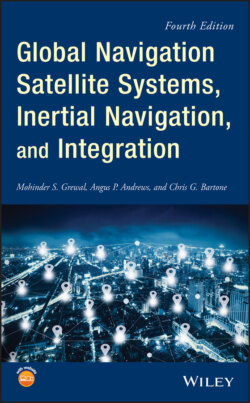Читать книгу Global Navigation Satellite Systems, Inertial Navigation, and Integration - Mohinder S. Grewal - Страница 69
2.5.2 User Velocity Calculations
ОглавлениеDifferentiate Eq. (2.21) with respect to time without Cb.
(2.41)
Differentiate Eq. (2.41) with respect to
(2.42)
where .
In classical navigation geometry, the components (3 × 3) of this unit vector are often called direction cosine. It is interesting to note that these components are the same as the position linearization shown in Eqs. (2.26a) and (2.26b).
Equations (2.42) and (2.26b) will be used in GPS/INS tightly coupled implementation as measurement equations for pseudoranges and/or delta pseudoranges in chapters 11 and 12 in the extended Kalman filters. Equation (2.27) will be used in integrity determination of GNSS satellites in Chapter 9 and from Eq. (2.41),
(2.43)
where
| = | range rate (known) | |
| ρ r | = | range (known) |
| (x, y, z) | = | satellite positions (known) |
| (, , ) | = | satellite rates (known) |
| X, Y, Z | = | user position (known from position calculations) |
| (, , ) | = | user velocity (unknown) |
For three satellites, Eq. (2.43) becomes
(2.44)
Equation (2.44) becomes
(2.45)
(2.46)
where
| D | = | known vector |
| N | = | known matrix |
| U v | = | unknown user velocity vector |
However, if the rank of N is <3, N will not be invertible.
